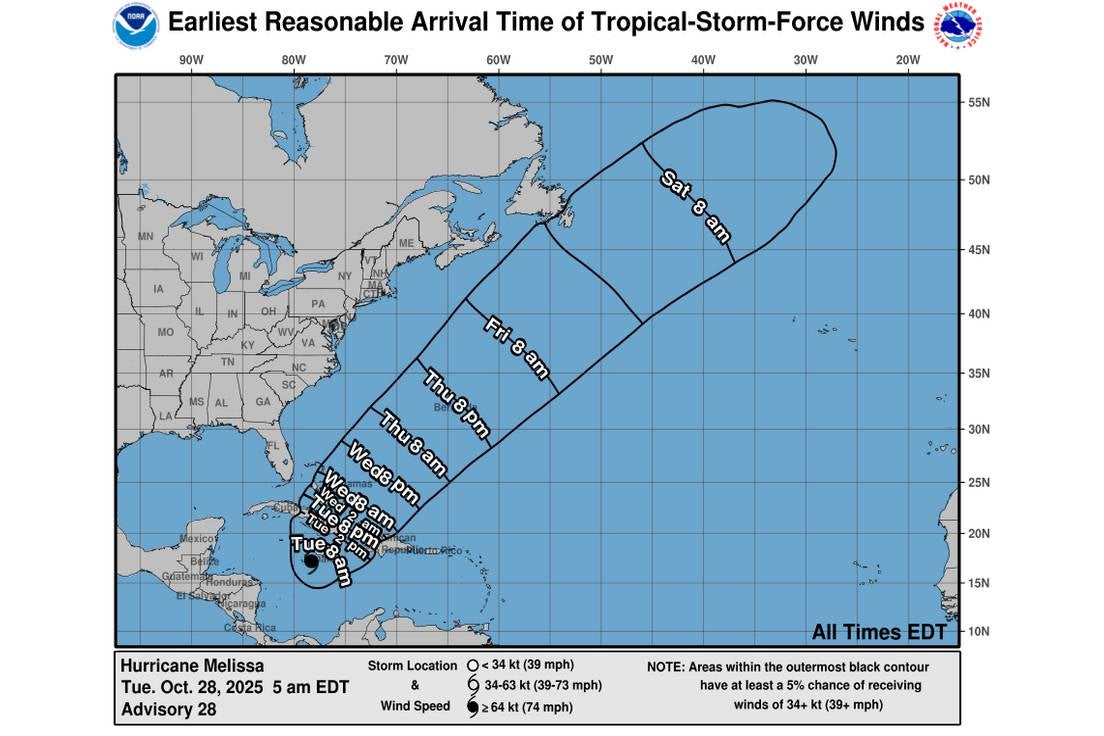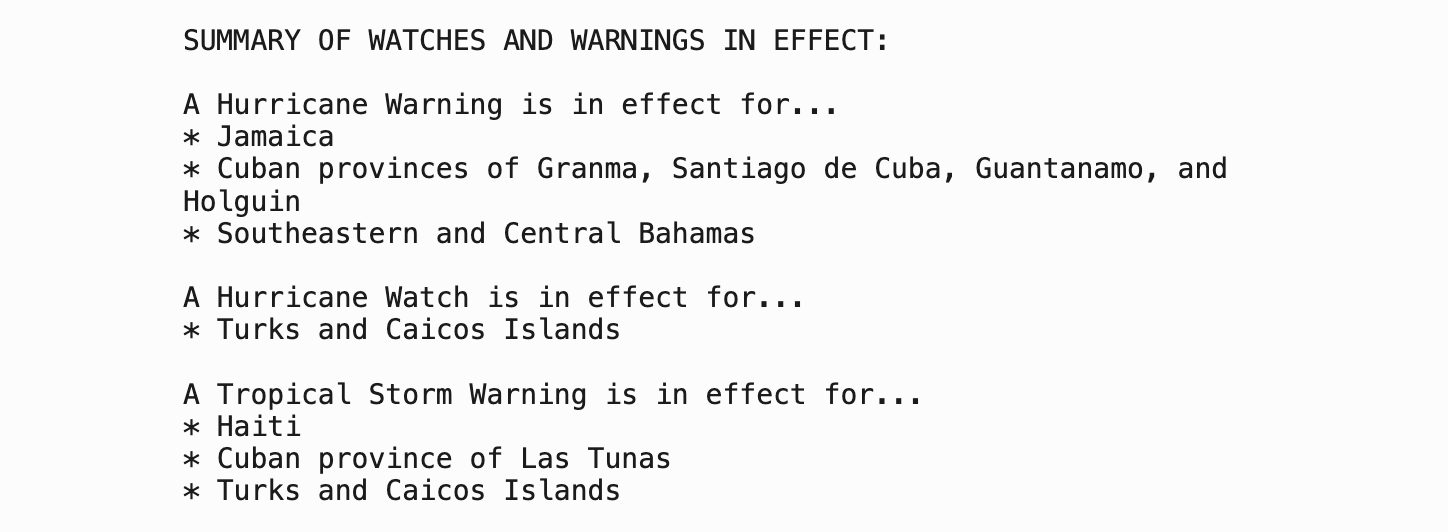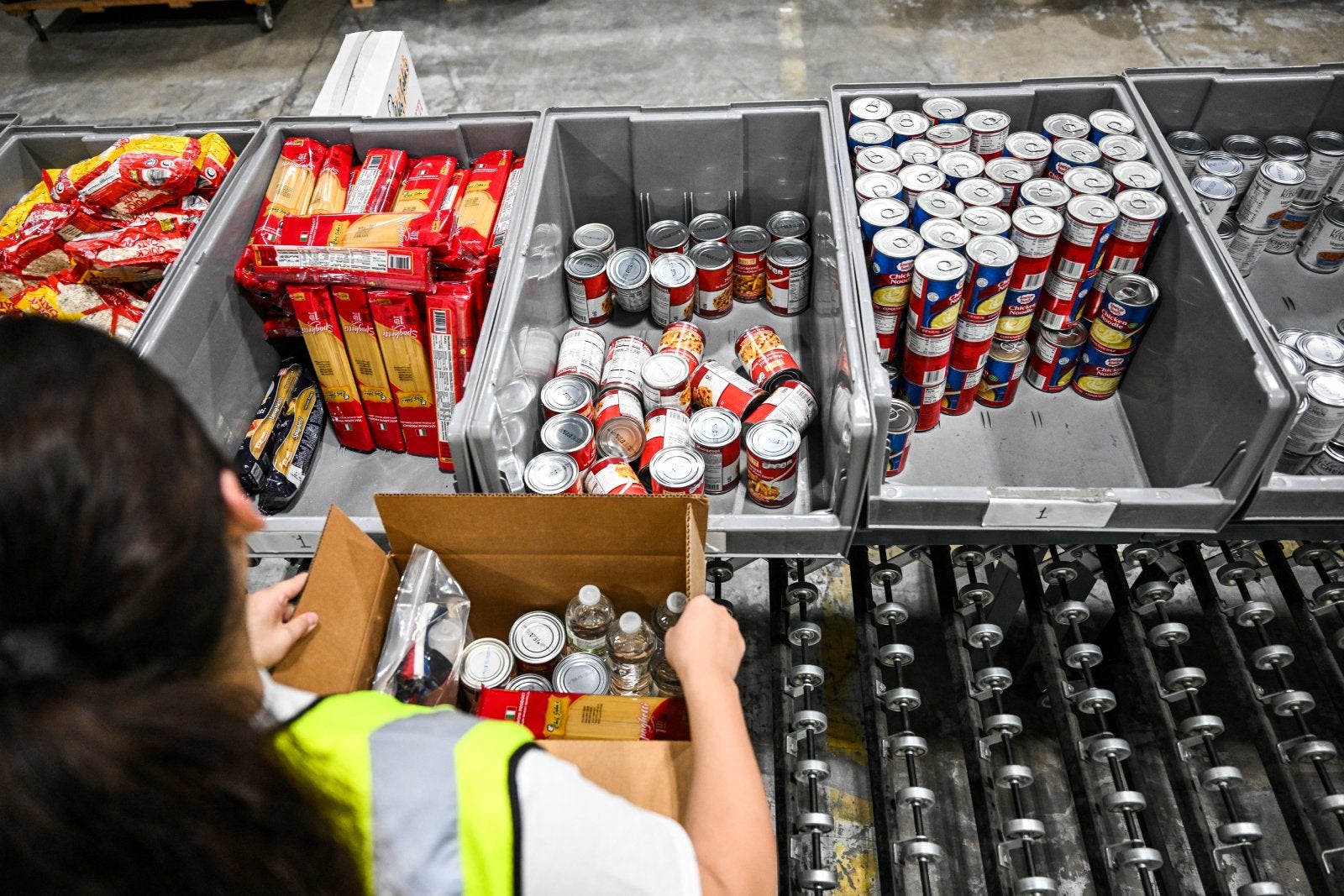Hurricane Melissa is predicted to make landfall in Jamaica on Tuesday morning as a Category 5 storm with 175 mph winds, making it the most powerful storm in the Atlantic Ocean this year.
The storm’s churning path is expected to hit the island at St. Elizabeth parish, a coastal area about 75 miles west of Kingston, the island’s capital. Weather services say there is a high risk of “catastrophic” damage and loss of life.
And it’s not just Jamaica that will be affected by Melissa. Current forecasts predict nearly 30 inches of rain to fall on the island and nearby in Cuba, the Dominican Republic, Haiti, the Bahamas and Turks and Caicos. And it’s possible that more islands may feel the brunt of the massive storm, too, with storm surges that can create significant waves throughout the week.
Here’s what you need to know if you have travel plans to Jamaica or the Caribbean this week — and what you can do to help in the storm’s aftermath.
Related: Top travel mistakes to avoid during hurricane season
Where is Hurricane Melissa?
Hurricane Melissa is currently a Category 5 hurricane sitting just southwest of Jamaica and traveling on a northeast trajectory that brings it directly over Jamaica and mostly affects the northeastern part of the Caribbean Sea in the Greater Antilles. As of Tuesday morning, winds were reported at 175 mph; a storm is considered a Category 5 once winds hit 157 mph. For any landmass in Melissa’s path, there is expected to be wide-ranging, sustained damage.
“The core of Melissa is expected to make landfall on Jamaica during the next several hours, move across southeastern Cuba Wednesday morning, and move across the southeastern or central Bahamas later on Wednesday,” the National Hurricane Center said on Tuesday morning.

Last year, Hurricane Beryl took a similar path over Jamaica as a Category 4 storm and caused widespread electrical and communications infrastructure damage. That storm headed northwest to the Gulf of Mexico.
Is it safe to travel to the Caribbean?
Since the Caribbean is one of the largest seas on earth, sprawling across over one million square miles, many areas will not feel much of Melissa’s wrath. For example, islands like Aruba that are closer to South America saw some rain last week as the storm made its way west, but it sustained no damage.

Reward your inbox with the TPG Daily newsletter
Join over 700,000 readers for breaking news, in-depth guides and exclusive deals from TPG’s experts
However, if you are planning travel to Jamaica, know that the island is expected to take a direct hit from a Category 5 hurricane and that expectations are that electricity and other infrastructure will be offline as a result for anywhere from weeks to months.
“The Government of Jamaica issued a Hurricane Warning for the island on October 24, 2025. All persons are urged to take the necessary precautions to ensure safety during this time,” according to the Jamaica Tourism Board’s website. Visit its Travel Alerts page for information on emergency services, flight cancellations and shelter locations.
The National Hurricane Center has several watches and warnings in effect that extend to the surrounding area.

Forecasters predict a storm surge of 9 to 13 feet, and the slow-moving storm is expected to dump nearly three feet of rain on the island. In addition to Haiti and Cuba, which are also directly in the hurricane’s path, nearby islands that may also feel this storm surge include the southeastern Bahamas and the Turks and Caicos. Wave swells that can cause life-threatening surf and rip current conditions are expected to reach the Cayman Islands in the next few days, and the Bahamas, the Turks and Caicos and Bermuda later this week.
If you have an upcoming trip to the Caribbean scheduled, you’ll want to stay abreast of the developments in your specific destination.
Airport closures and airline waivers
Both of Jamaica’s main airports closed this past weekend ahead of the storm. Norman Manley International Airport (KIN) in Kingston, closed after its final flight on Saturday, Oct. 25, and Sangster International Airport (MBJ) in Montego Bay, closed midday on Sun., Oct. 26. Neither has posted a predicted reopening date.
Flights are still operating out of Turks and Caicos, which is under a hurricane watch. According to Experience Turks and Caicos, the country’s destination marketing organization, both American Airlines and JetBlue are currently operating larger aircraft to accommodate people who wish to leave the islands ahead of the storm.
Airlines that service Jamaica and other Caribbean islands are offering various travel waivers. The particulars of each waiver vary, but they generally apply to flights to, from or through various airports in Jamaica and other islands. With the waivers, travelers can change their flights without having to pay a fare difference.
Here are a few airline waiver examples:
- Delta: For the Oct. 25 to 30 travel schedule to/from/through Jamaica and Turks and Caicos, travel must be rebooked by Nov. 2. There is no change fee, but passengers will need to pay the difference in ticketed price for travel after Nov. 2.
- United: For travel scheduled to/from Jamaica, Turks and Caicos from Oct. 25 to 29, and Bermuda from Oct. 30 to Nov. 2, there is no change fee or price difference charged for flights until Nov. 5 (for Jamaica and Turks and Caicos) and Nov. 9 (for Bermuda). (Note there are no change fees on United at any time.)
- American: This is a wider waiver that extends to the Turks and Caicos, Jamaica, Cuba and George Town, Bahamas. The change fee will be waived for scheduled travel Oct. 25 to 29, and changes must be booked by Nov. 2.
- JetBlue: Change/cancel fees and fare differences are waived for travel to/from Jamaica from Oct. 25 to 31; customers may rebook their flights through Nov. 8. For flights to/from Turks and Caicos, fees and fare differences are waived for travel from Oct. 28 to 30, and can be rebooked through Nov. 5.
Check with your airline for more details if you have travel coming up this week.
What to do if you have a trip booked to Jamaica or the Caribbean
If you reserved directly with a hotel, first check its website and see if it has posted any updates. You can also call the hotel directly or the main reservations number. Keep in mind that many properties may likely be managing the crisis, so calling the property directly should be a last option.
If you booked through a third-party online travel agency or aggregator like Expedia or Travelocity, it’s important to understand the cancellation policy. The OTA still owns your reservation prior to your travel; if you contact the hotel directly, it will likely refer you back to the OTA or travel portal for assistance.
If you have a cruise planned to the Caribbean, check with your cruise line about updated sailing plans.
Related: Cruising during hurricane season: What to know
If you have travel insurance already purchased, then you should be able to recoup all of your trip expenses if you are traveling to an area directly affected by Hurricane Melissa. As we’ve reported previously, the time to buy insurance is before a storm is named. Once it’s already been identified, it’s a “known event,” and you can no longer purchase coverage for that storm.
How to help

If you’d like to help those in the storm’s path, there are several options to explore:
Bottom line
Hurricane Melissa is expected to make landfall in Jamaica on Tuesday morning as an incredibly forceful Category 5 hurricane. It will then head northeast in the Caribbean over Cuba and Haiti and affect areas of the Bahamas and the Turks and Caicos.
If you have plans to travel to an area affected by the hurricane, it would be prudent to cancel or delay your plans until later.
For more helpful tips on navigating travel during hurricane season, read: